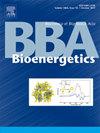ATP requirements for growth reveal the bioenergetic impact of mitochondrial symbiosis
IF 2.7
2区 生物学
Q2 BIOCHEMISTRY & MOLECULAR BIOLOGY
引用次数: 0
Abstract
Studies by microbiologists in the 1970s provided robust estimates for the energy supply and demand of a prokaryotic cell. The amount of ATP needed to support growth was calculated from the chemical composition of the cell and known enzymatic pathways that synthesize its constituents from known substrates in culture. Starting in 2015, geneticists and evolutionary biologists began investigating the bioenergetic role of mitochondria at eukaryote origin and energy in metazoan evolution using their own, widely trusted—but hitherto unvetted—model for the costs of growth in terms of ATP per cell. The more recent model contains, however, a severe and previously unrecognized error that systematically overestimates the ATP cost of amino acid synthesis up to 200-fold. The error applies to all organisms studied by such models and leads to conspicuously false inferences, for example that the synthesis of an average amino acid in humans requires 30 ATP, which no biochemistry textbook will confirm. Their ATP ‘cost’ calculations would require that E. coli obtains ~100 ATP per glucose and that mammals obtain ~240 ATP per glucose, untenable propositions that invalidate and void all evolutionary inferences so based. By contrast, established methods for estimating the ATP cost of microbial growth show that the first mitochondrial endosymbionts could have easily doubled the host's available ATP pool, provided (i) that genes for growth on environmental amino acids were transferred from the mitochondrial symbiont to the archaeal host, and (ii) that the host for mitochondrial origin was an autotroph using the acetyl-CoA pathway. Stated in simple terms, the significance of these findings are this: Life is a chemical reaction. It requires energy release in order to proceed. The currency of energy in cells is adenosine triphosphate, ATP. Five decades ago, microbiologists were able to measure and understand the amount of ATP that cells require to grow. New studies by evolutionary biologists have appeared in the meantime that brush aside the older microbiological findings, using their own methods to calculate the ATP cost of growth instead. Science is, however, an imperfect undertaking. The new studies contain a major error, similar to conflating centimeters with yards. The error affects many publications and their conclusions. Using the old methods, we can still meaningfully study the role of energy in evolution, including the origin of complex, nucleus-bearing cells.
生长所需的ATP揭示了线粒体共生的生物能影响。
微生物学家在20世纪70年代的研究为原核细胞的能量供应和需求提供了可靠的估计。支持生长所需ATP的数量是根据细胞的化学组成和已知的酶促途径来计算的,这些酶促途径是从已知的培养基中合成其成分的。从2015年开始,遗传学家和进化生物学家开始研究线粒体在真核生物起源中的生物能量作用,以及在后生动物进化中的能量,使用他们自己的、广泛信任的——但迄今为止尚未揭示的——以每个细胞ATP为单位的生长成本模型。然而,最近的模型包含了一个严重的、以前未被认识到的错误,即系统性地高估了氨基酸合成的ATP成本,最高可达200倍。这种错误适用于用这种模型研究的所有生物体,并导致明显错误的推论,例如,人类平均一个氨基酸的合成需要30个ATP,这是没有生物化学教科书可以证实的。他们的ATP“成本”计算要求大肠杆菌每葡萄糖获得约100个ATP,哺乳动物每葡萄糖获得约240个ATP,这是站不住脚的命题,使所有基于此的进化推断无效。相比之下,现有的估算微生物生长ATP成本的方法表明,第一个线粒体内共生体可以很容易地使宿主的可用ATP池翻倍,前提是:(i)在环境氨基酸上生长的基因从线粒体共生体转移到古菌宿主,(ii)线粒体起源的宿主是一个使用乙酰辅酶a途径的自养生物。意义声明:生命是一种化学反应。它需要能量释放才能进行。细胞中的能量货币是三磷酸腺苷ATP。50年前,微生物学家能够测量和了解细胞生长所需的ATP量。与此同时,进化生物学家的新研究也出现了,他们摒弃了以前的微生物学发现,转而使用自己的方法来计算生长所需的ATP成本。然而,科学是一项不完美的事业。新的研究包含一个重大错误,类似于将厘米与码混淆。这个错误影响了许多出版物和他们的结论。使用旧的方法,我们仍然可以有意义地研究能量在进化中的作用,包括复杂的有核细胞的起源。
本文章由计算机程序翻译,如有差异,请以英文原文为准。
求助全文
约1分钟内获得全文
求助全文
来源期刊

Biochimica et Biophysica Acta-Bioenergetics
生物-生化与分子生物学
CiteScore
9.50
自引率
7.00%
发文量
363
审稿时长
92 days
期刊介绍:
BBA Bioenergetics covers the area of biological membranes involved in energy transfer and conversion. In particular, it focuses on the structures obtained by X-ray crystallography and other approaches, and molecular mechanisms of the components of photosynthesis, mitochondrial and bacterial respiration, oxidative phosphorylation, motility and transport. It spans applications of structural biology, molecular modeling, spectroscopy and biophysics in these systems, through bioenergetic aspects of mitochondrial biology including biomedicine aspects of energy metabolism in mitochondrial disorders, neurodegenerative diseases like Parkinson''s and Alzheimer''s, aging, diabetes and even cancer.
 求助内容:
求助内容: 应助结果提醒方式:
应助结果提醒方式:


